Management Accounting Report for Excite Entertainment Ltd: Analysis
VerifiedAdded on 2021/01/02
|18
|5737
|68
Report
AI Summary
This report provides a comprehensive analysis of management accounting principles and their application within Excite Entertainment Ltd. It begins by differentiating between financial and management accounting, followed by a detailed exploration of various management accounting systems, including inventory management and cost accounting systems. The report then examines different management accounting reporting methods, such as budget reports, performance reports, and job costing reports, highlighting their significance in the company's operations. The integration of management accounting systems and reporting is discussed, emphasizing how these elements enhance the company's efficiency and performance. Furthermore, the report includes the preparation of an income statement using both marginal and absorption costing methods. It analyzes the benefits and limitations of planning tools used for budgetary control, and explores the application of management accounting systems in solving financial problems, including the use of CVP analysis. The report aims to provide valuable insights into how management accounting can support strategic decision-making and improve financial outcomes within Excite Entertainment Ltd.

Management Accounting
report for Excite
Entertainment Ltd
report for Excite
Entertainment Ltd
Paraphrase This Document
Need a fresh take? Get an instant paraphrase of this document with our AI Paraphraser
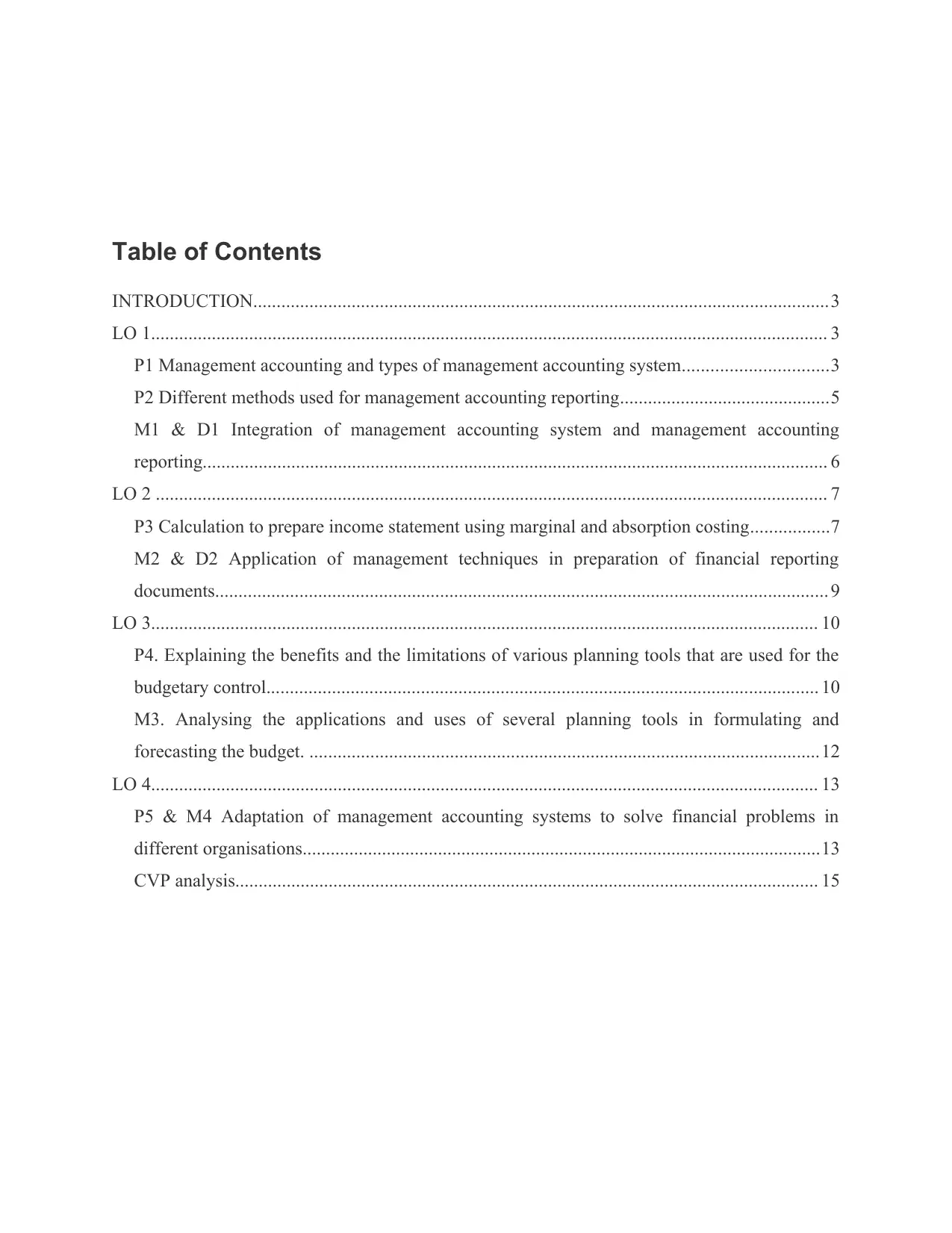
Table of Contents
INTRODUCTION...........................................................................................................................3
LO 1................................................................................................................................................. 3
P1 Management accounting and types of management accounting system...............................3
P2 Different methods used for management accounting reporting.............................................5
M1 & D1 Integration of management accounting system and management accounting
reporting...................................................................................................................................... 6
LO 2 ................................................................................................................................................ 7
P3 Calculation to prepare income statement using marginal and absorption costing.................7
M2 & D2 Application of management techniques in preparation of financial reporting
documents................................................................................................................................... 9
LO 3............................................................................................................................................... 10
P4. Explaining the benefits and the limitations of various planning tools that are used for the
budgetary control...................................................................................................................... 10
M3. Analysing the applications and uses of several planning tools in formulating and
forecasting the budget. .............................................................................................................12
LO 4............................................................................................................................................... 13
P5 & M4 Adaptation of management accounting systems to solve financial problems in
different organisations...............................................................................................................13
CVP analysis............................................................................................................................. 15
INTRODUCTION...........................................................................................................................3
LO 1................................................................................................................................................. 3
P1 Management accounting and types of management accounting system...............................3
P2 Different methods used for management accounting reporting.............................................5
M1 & D1 Integration of management accounting system and management accounting
reporting...................................................................................................................................... 6
LO 2 ................................................................................................................................................ 7
P3 Calculation to prepare income statement using marginal and absorption costing.................7
M2 & D2 Application of management techniques in preparation of financial reporting
documents................................................................................................................................... 9
LO 3............................................................................................................................................... 10
P4. Explaining the benefits and the limitations of various planning tools that are used for the
budgetary control...................................................................................................................... 10
M3. Analysing the applications and uses of several planning tools in formulating and
forecasting the budget. .............................................................................................................12
LO 4............................................................................................................................................... 13
P5 & M4 Adaptation of management accounting systems to solve financial problems in
different organisations...............................................................................................................13
CVP analysis............................................................................................................................. 15
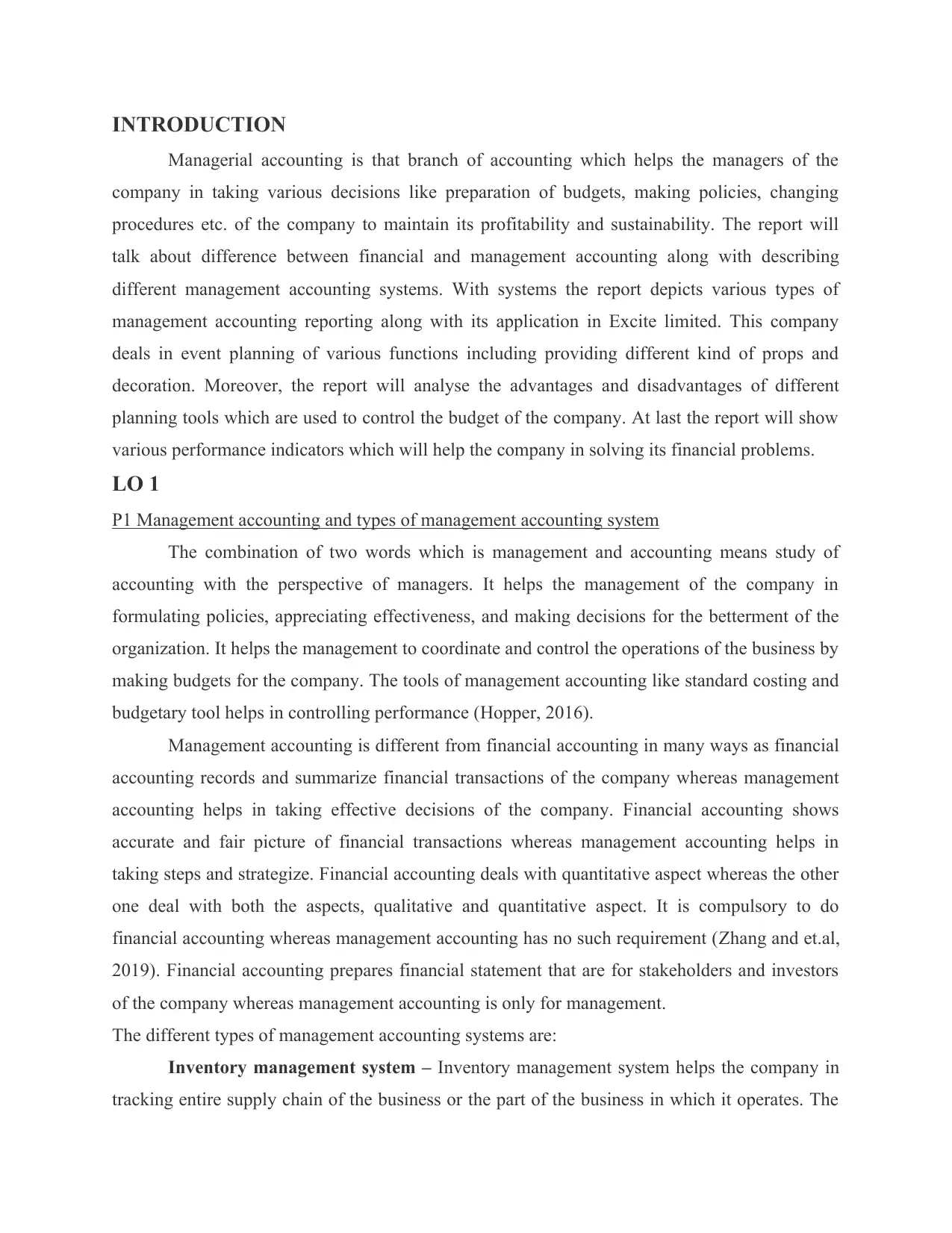
INTRODUCTION
Managerial accounting is that branch of accounting which helps the managers of the
company in taking various decisions like preparation of budgets, making policies, changing
procedures etc. of the company to maintain its profitability and sustainability. The report will
talk about difference between financial and management accounting along with describing
different management accounting systems. With systems the report depicts various types of
management accounting reporting along with its application in Excite limited. This company
deals in event planning of various functions including providing different kind of props and
decoration. Moreover, the report will analyse the advantages and disadvantages of different
planning tools which are used to control the budget of the company. At last the report will show
various performance indicators which will help the company in solving its financial problems.
LO 1
P1 Management accounting and types of management accounting system
The combination of two words which is management and accounting means study of
accounting with the perspective of managers. It helps the management of the company in
formulating policies, appreciating effectiveness, and making decisions for the betterment of the
organization. It helps the management to coordinate and control the operations of the business by
making budgets for the company. The tools of management accounting like standard costing and
budgetary tool helps in controlling performance (Hopper, 2016).
Management accounting is different from financial accounting in many ways as financial
accounting records and summarize financial transactions of the company whereas management
accounting helps in taking effective decisions of the company. Financial accounting shows
accurate and fair picture of financial transactions whereas management accounting helps in
taking steps and strategize. Financial accounting deals with quantitative aspect whereas the other
one deal with both the aspects, qualitative and quantitative aspect. It is compulsory to do
financial accounting whereas management accounting has no such requirement (Zhang and et.al,
2019). Financial accounting prepares financial statement that are for stakeholders and investors
of the company whereas management accounting is only for management.
The different types of management accounting systems are:
Inventory management system – Inventory management system helps the company in
tracking entire supply chain of the business or the part of the business in which it operates. The
Managerial accounting is that branch of accounting which helps the managers of the
company in taking various decisions like preparation of budgets, making policies, changing
procedures etc. of the company to maintain its profitability and sustainability. The report will
talk about difference between financial and management accounting along with describing
different management accounting systems. With systems the report depicts various types of
management accounting reporting along with its application in Excite limited. This company
deals in event planning of various functions including providing different kind of props and
decoration. Moreover, the report will analyse the advantages and disadvantages of different
planning tools which are used to control the budget of the company. At last the report will show
various performance indicators which will help the company in solving its financial problems.
LO 1
P1 Management accounting and types of management accounting system
The combination of two words which is management and accounting means study of
accounting with the perspective of managers. It helps the management of the company in
formulating policies, appreciating effectiveness, and making decisions for the betterment of the
organization. It helps the management to coordinate and control the operations of the business by
making budgets for the company. The tools of management accounting like standard costing and
budgetary tool helps in controlling performance (Hopper, 2016).
Management accounting is different from financial accounting in many ways as financial
accounting records and summarize financial transactions of the company whereas management
accounting helps in taking effective decisions of the company. Financial accounting shows
accurate and fair picture of financial transactions whereas management accounting helps in
taking steps and strategize. Financial accounting deals with quantitative aspect whereas the other
one deal with both the aspects, qualitative and quantitative aspect. It is compulsory to do
financial accounting whereas management accounting has no such requirement (Zhang and et.al,
2019). Financial accounting prepares financial statement that are for stakeholders and investors
of the company whereas management accounting is only for management.
The different types of management accounting systems are:
Inventory management system – Inventory management system helps the company in
tracking entire supply chain of the business or the part of the business in which it operates. The
⊘ This is a preview!⊘
Do you want full access?
Subscribe today to unlock all pages.

Trusted by 1+ million students worldwide
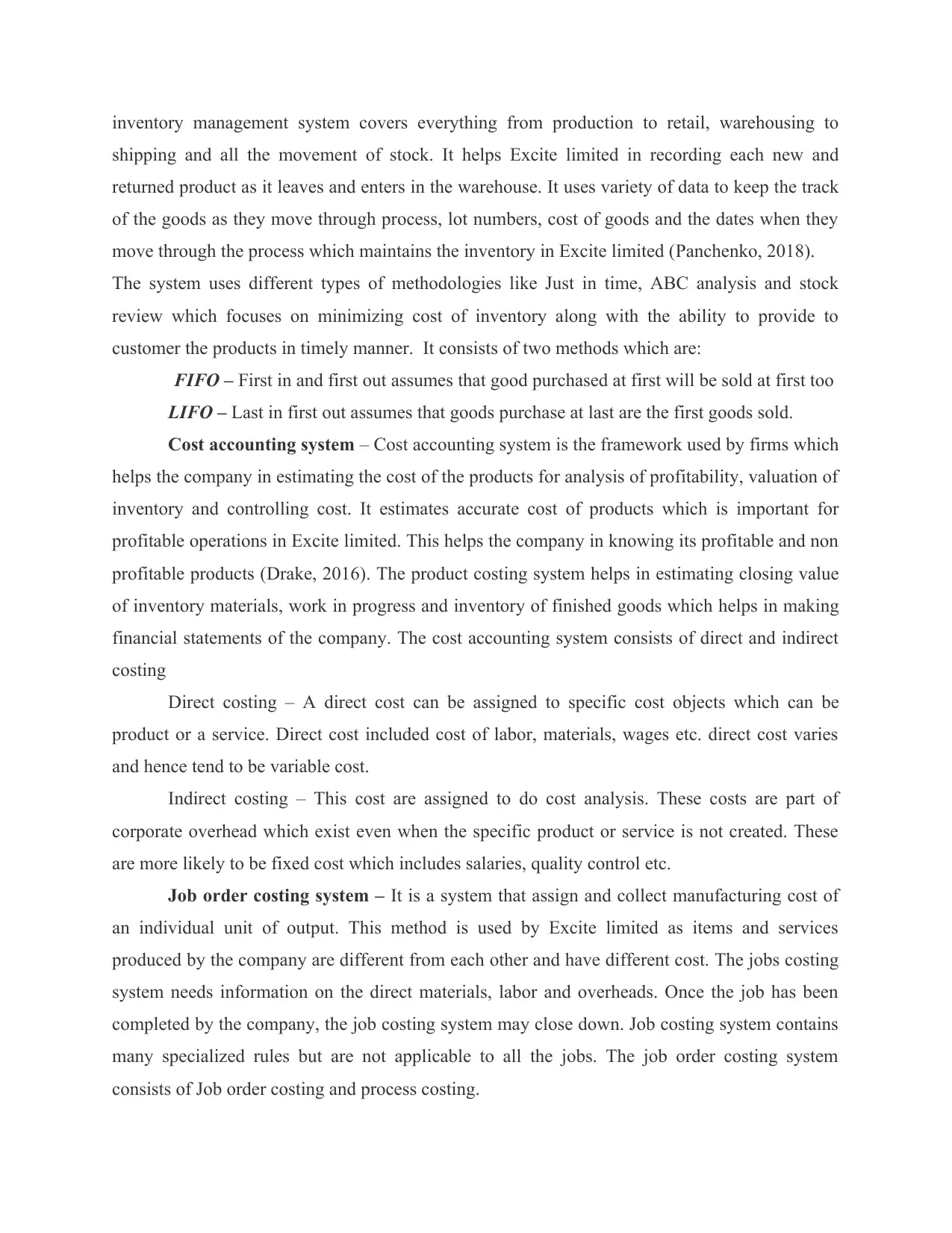
inventory management system covers everything from production to retail, warehousing to
shipping and all the movement of stock. It helps Excite limited in recording each new and
returned product as it leaves and enters in the warehouse. It uses variety of data to keep the track
of the goods as they move through process, lot numbers, cost of goods and the dates when they
move through the process which maintains the inventory in Excite limited (Panchenko, 2018).
The system uses different types of methodologies like Just in time, ABC analysis and stock
review which focuses on minimizing cost of inventory along with the ability to provide to
customer the products in timely manner. It consists of two methods which are:
FIFO – First in and first out assumes that good purchased at first will be sold at first too
LIFO – Last in first out assumes that goods purchase at last are the first goods sold.
Cost accounting system – Cost accounting system is the framework used by firms which
helps the company in estimating the cost of the products for analysis of profitability, valuation of
inventory and controlling cost. It estimates accurate cost of products which is important for
profitable operations in Excite limited. This helps the company in knowing its profitable and non
profitable products (Drake, 2016). The product costing system helps in estimating closing value
of inventory materials, work in progress and inventory of finished goods which helps in making
financial statements of the company. The cost accounting system consists of direct and indirect
costing
Direct costing – A direct cost can be assigned to specific cost objects which can be
product or a service. Direct cost included cost of labor, materials, wages etc. direct cost varies
and hence tend to be variable cost.
Indirect costing – This cost are assigned to do cost analysis. These costs are part of
corporate overhead which exist even when the specific product or service is not created. These
are more likely to be fixed cost which includes salaries, quality control etc.
Job order costing system – It is a system that assign and collect manufacturing cost of
an individual unit of output. This method is used by Excite limited as items and services
produced by the company are different from each other and have different cost. The jobs costing
system needs information on the direct materials, labor and overheads. Once the job has been
completed by the company, the job costing system may close down. Job costing system contains
many specialized rules but are not applicable to all the jobs. The job order costing system
consists of Job order costing and process costing.
shipping and all the movement of stock. It helps Excite limited in recording each new and
returned product as it leaves and enters in the warehouse. It uses variety of data to keep the track
of the goods as they move through process, lot numbers, cost of goods and the dates when they
move through the process which maintains the inventory in Excite limited (Panchenko, 2018).
The system uses different types of methodologies like Just in time, ABC analysis and stock
review which focuses on minimizing cost of inventory along with the ability to provide to
customer the products in timely manner. It consists of two methods which are:
FIFO – First in and first out assumes that good purchased at first will be sold at first too
LIFO – Last in first out assumes that goods purchase at last are the first goods sold.
Cost accounting system – Cost accounting system is the framework used by firms which
helps the company in estimating the cost of the products for analysis of profitability, valuation of
inventory and controlling cost. It estimates accurate cost of products which is important for
profitable operations in Excite limited. This helps the company in knowing its profitable and non
profitable products (Drake, 2016). The product costing system helps in estimating closing value
of inventory materials, work in progress and inventory of finished goods which helps in making
financial statements of the company. The cost accounting system consists of direct and indirect
costing
Direct costing – A direct cost can be assigned to specific cost objects which can be
product or a service. Direct cost included cost of labor, materials, wages etc. direct cost varies
and hence tend to be variable cost.
Indirect costing – This cost are assigned to do cost analysis. These costs are part of
corporate overhead which exist even when the specific product or service is not created. These
are more likely to be fixed cost which includes salaries, quality control etc.
Job order costing system – It is a system that assign and collect manufacturing cost of
an individual unit of output. This method is used by Excite limited as items and services
produced by the company are different from each other and have different cost. The jobs costing
system needs information on the direct materials, labor and overheads. Once the job has been
completed by the company, the job costing system may close down. Job costing system contains
many specialized rules but are not applicable to all the jobs. The job order costing system
consists of Job order costing and process costing.
Paraphrase This Document
Need a fresh take? Get an instant paraphrase of this document with our AI Paraphraser
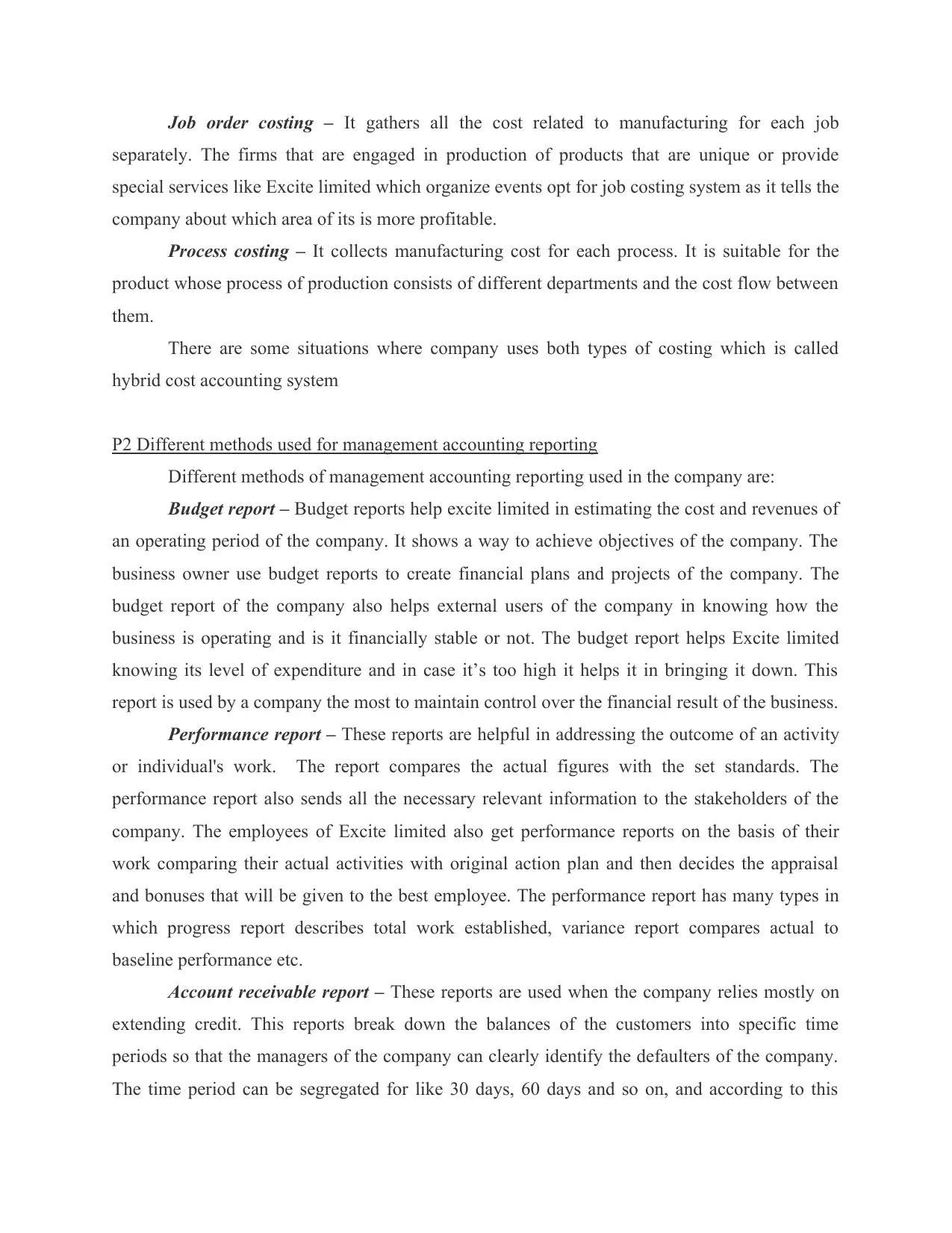
Job order costing – It gathers all the cost related to manufacturing for each job
separately. The firms that are engaged in production of products that are unique or provide
special services like Excite limited which organize events opt for job costing system as it tells the
company about which area of its is more profitable.
Process costing – It collects manufacturing cost for each process. It is suitable for the
product whose process of production consists of different departments and the cost flow between
them.
There are some situations where company uses both types of costing which is called
hybrid cost accounting system
P2 Different methods used for management accounting reporting
Different methods of management accounting reporting used in the company are:
Budget report – Budget reports help excite limited in estimating the cost and revenues of
an operating period of the company. It shows a way to achieve objectives of the company. The
business owner use budget reports to create financial plans and projects of the company. The
budget report of the company also helps external users of the company in knowing how the
business is operating and is it financially stable or not. The budget report helps Excite limited
knowing its level of expenditure and in case it’s too high it helps it in bringing it down. This
report is used by a company the most to maintain control over the financial result of the business.
Performance report – These reports are helpful in addressing the outcome of an activity
or individual's work. The report compares the actual figures with the set standards. The
performance report also sends all the necessary relevant information to the stakeholders of the
company. The employees of Excite limited also get performance reports on the basis of their
work comparing their actual activities with original action plan and then decides the appraisal
and bonuses that will be given to the best employee. The performance report has many types in
which progress report describes total work established, variance report compares actual to
baseline performance etc.
Account receivable report – These reports are used when the company relies mostly on
extending credit. This reports break down the balances of the customers into specific time
periods so that the managers of the company can clearly identify the defaulters of the company.
The time period can be segregated for like 30 days, 60 days and so on, and according to this
separately. The firms that are engaged in production of products that are unique or provide
special services like Excite limited which organize events opt for job costing system as it tells the
company about which area of its is more profitable.
Process costing – It collects manufacturing cost for each process. It is suitable for the
product whose process of production consists of different departments and the cost flow between
them.
There are some situations where company uses both types of costing which is called
hybrid cost accounting system
P2 Different methods used for management accounting reporting
Different methods of management accounting reporting used in the company are:
Budget report – Budget reports help excite limited in estimating the cost and revenues of
an operating period of the company. It shows a way to achieve objectives of the company. The
business owner use budget reports to create financial plans and projects of the company. The
budget report of the company also helps external users of the company in knowing how the
business is operating and is it financially stable or not. The budget report helps Excite limited
knowing its level of expenditure and in case it’s too high it helps it in bringing it down. This
report is used by a company the most to maintain control over the financial result of the business.
Performance report – These reports are helpful in addressing the outcome of an activity
or individual's work. The report compares the actual figures with the set standards. The
performance report also sends all the necessary relevant information to the stakeholders of the
company. The employees of Excite limited also get performance reports on the basis of their
work comparing their actual activities with original action plan and then decides the appraisal
and bonuses that will be given to the best employee. The performance report has many types in
which progress report describes total work established, variance report compares actual to
baseline performance etc.
Account receivable report – These reports are used when the company relies mostly on
extending credit. This reports break down the balances of the customers into specific time
periods so that the managers of the company can clearly identify the defaulters of the company.
The time period can be segregated for like 30 days, 60 days and so on, and according to this
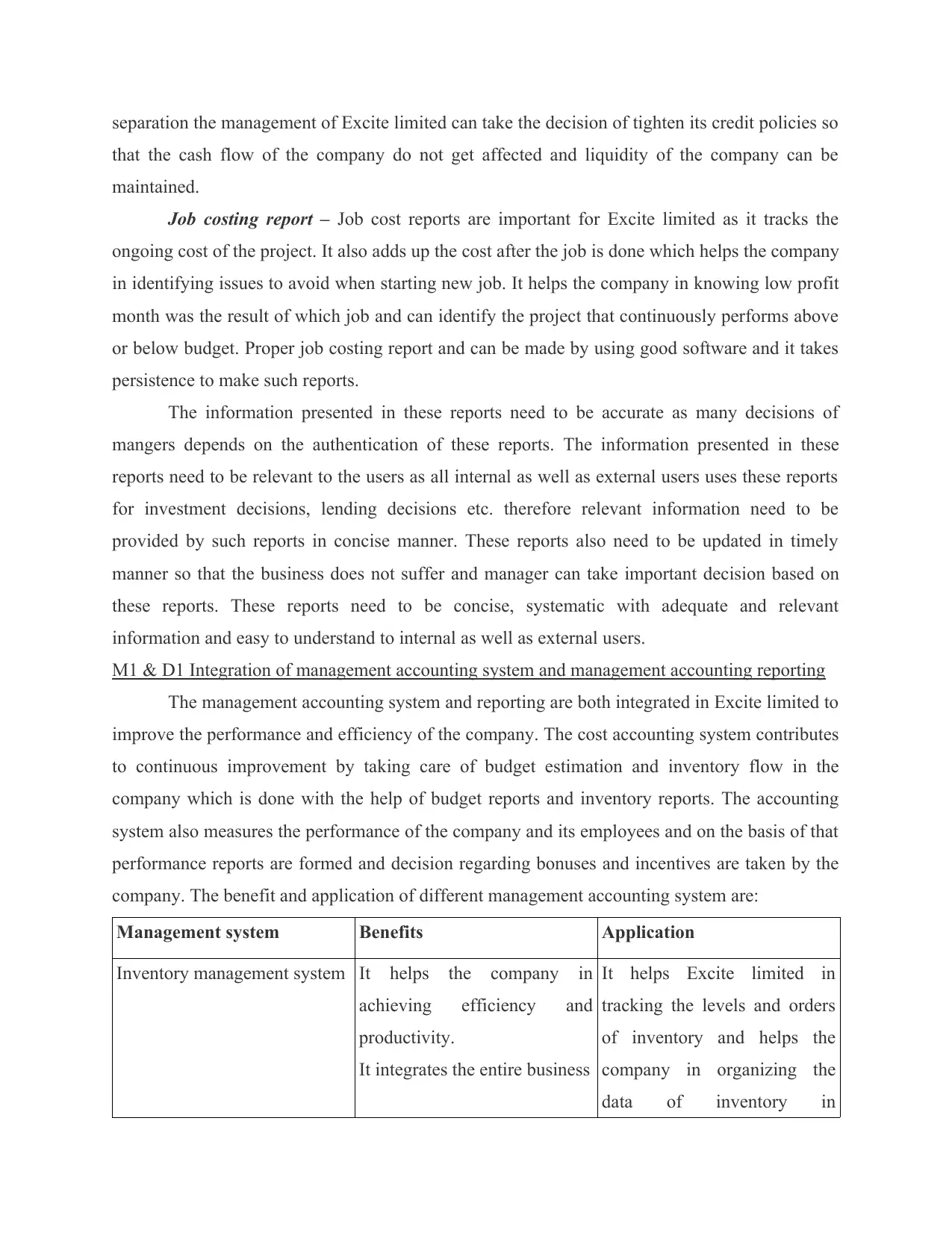
separation the management of Excite limited can take the decision of tighten its credit policies so
that the cash flow of the company do not get affected and liquidity of the company can be
maintained.
Job costing report – Job cost reports are important for Excite limited as it tracks the
ongoing cost of the project. It also adds up the cost after the job is done which helps the company
in identifying issues to avoid when starting new job. It helps the company in knowing low profit
month was the result of which job and can identify the project that continuously performs above
or below budget. Proper job costing report and can be made by using good software and it takes
persistence to make such reports.
The information presented in these reports need to be accurate as many decisions of
mangers depends on the authentication of these reports. The information presented in these
reports need to be relevant to the users as all internal as well as external users uses these reports
for investment decisions, lending decisions etc. therefore relevant information need to be
provided by such reports in concise manner. These reports also need to be updated in timely
manner so that the business does not suffer and manager can take important decision based on
these reports. These reports need to be concise, systematic with adequate and relevant
information and easy to understand to internal as well as external users.
M1 & D1 Integration of management accounting system and management accounting reporting
The management accounting system and reporting are both integrated in Excite limited to
improve the performance and efficiency of the company. The cost accounting system contributes
to continuous improvement by taking care of budget estimation and inventory flow in the
company which is done with the help of budget reports and inventory reports. The accounting
system also measures the performance of the company and its employees and on the basis of that
performance reports are formed and decision regarding bonuses and incentives are taken by the
company. The benefit and application of different management accounting system are:
Management system Benefits Application
Inventory management system It helps the company in
achieving efficiency and
productivity.
It integrates the entire business
It helps Excite limited in
tracking the levels and orders
of inventory and helps the
company in organizing the
data of inventory in
that the cash flow of the company do not get affected and liquidity of the company can be
maintained.
Job costing report – Job cost reports are important for Excite limited as it tracks the
ongoing cost of the project. It also adds up the cost after the job is done which helps the company
in identifying issues to avoid when starting new job. It helps the company in knowing low profit
month was the result of which job and can identify the project that continuously performs above
or below budget. Proper job costing report and can be made by using good software and it takes
persistence to make such reports.
The information presented in these reports need to be accurate as many decisions of
mangers depends on the authentication of these reports. The information presented in these
reports need to be relevant to the users as all internal as well as external users uses these reports
for investment decisions, lending decisions etc. therefore relevant information need to be
provided by such reports in concise manner. These reports also need to be updated in timely
manner so that the business does not suffer and manager can take important decision based on
these reports. These reports need to be concise, systematic with adequate and relevant
information and easy to understand to internal as well as external users.
M1 & D1 Integration of management accounting system and management accounting reporting
The management accounting system and reporting are both integrated in Excite limited to
improve the performance and efficiency of the company. The cost accounting system contributes
to continuous improvement by taking care of budget estimation and inventory flow in the
company which is done with the help of budget reports and inventory reports. The accounting
system also measures the performance of the company and its employees and on the basis of that
performance reports are formed and decision regarding bonuses and incentives are taken by the
company. The benefit and application of different management accounting system are:
Management system Benefits Application
Inventory management system It helps the company in
achieving efficiency and
productivity.
It integrates the entire business
It helps Excite limited in
tracking the levels and orders
of inventory and helps the
company in organizing the
data of inventory in
⊘ This is a preview!⊘
Do you want full access?
Subscribe today to unlock all pages.

Trusted by 1+ million students worldwide
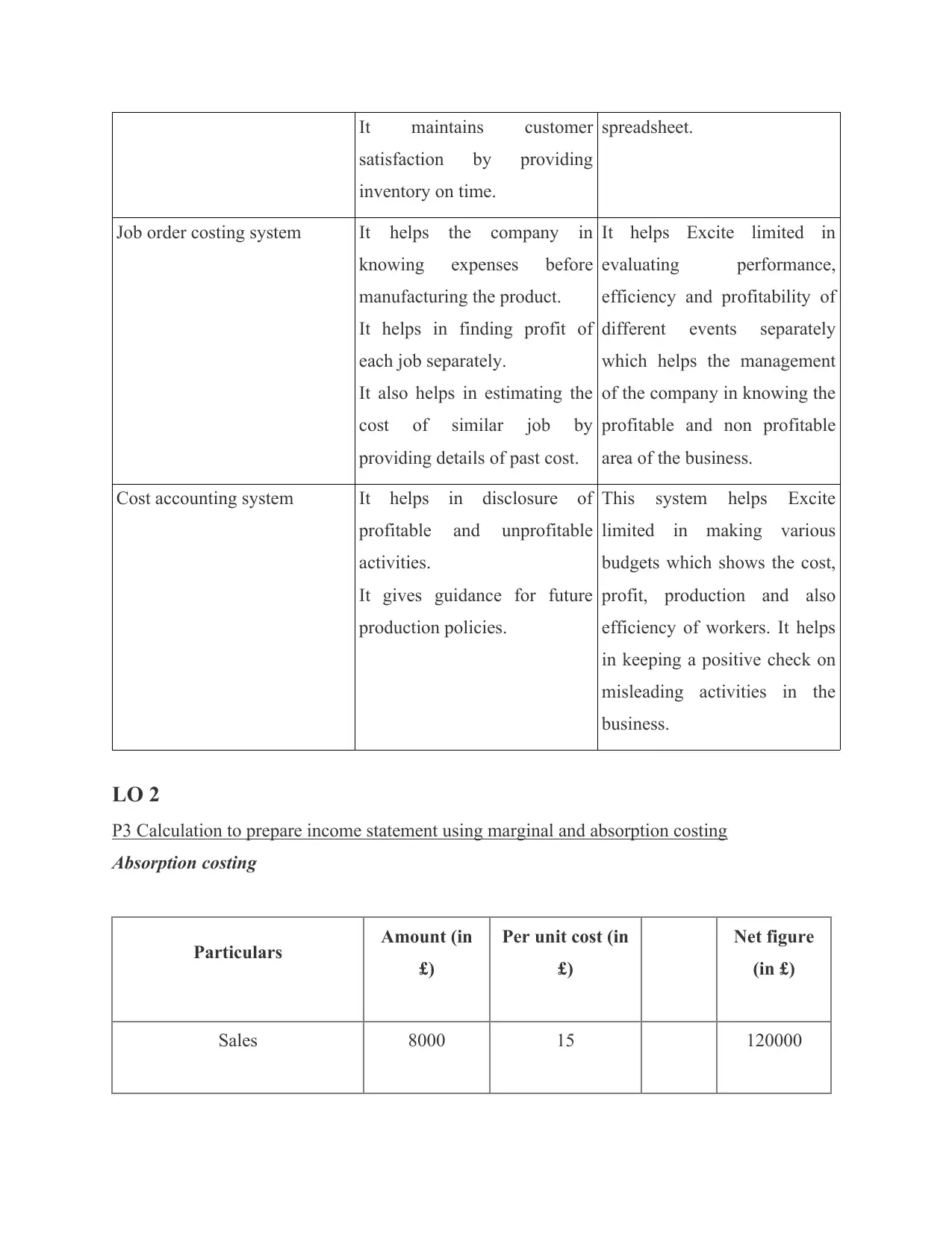
It maintains customer
satisfaction by providing
inventory on time.
spreadsheet.
Job order costing system It helps the company in
knowing expenses before
manufacturing the product.
It helps in finding profit of
each job separately.
It also helps in estimating the
cost of similar job by
providing details of past cost.
It helps Excite limited in
evaluating performance,
efficiency and profitability of
different events separately
which helps the management
of the company in knowing the
profitable and non profitable
area of the business.
Cost accounting system It helps in disclosure of
profitable and unprofitable
activities.
It gives guidance for future
production policies.
This system helps Excite
limited in making various
budgets which shows the cost,
profit, production and also
efficiency of workers. It helps
in keeping a positive check on
misleading activities in the
business.
LO 2
P3 Calculation to prepare income statement using marginal and absorption costing
Absorption costing
Particulars Amount (in
£)
Per unit cost (in
£)
Net figure
(in £)
Sales 8000 15 120000
satisfaction by providing
inventory on time.
spreadsheet.
Job order costing system It helps the company in
knowing expenses before
manufacturing the product.
It helps in finding profit of
each job separately.
It also helps in estimating the
cost of similar job by
providing details of past cost.
It helps Excite limited in
evaluating performance,
efficiency and profitability of
different events separately
which helps the management
of the company in knowing the
profitable and non profitable
area of the business.
Cost accounting system It helps in disclosure of
profitable and unprofitable
activities.
It gives guidance for future
production policies.
This system helps Excite
limited in making various
budgets which shows the cost,
profit, production and also
efficiency of workers. It helps
in keeping a positive check on
misleading activities in the
business.
LO 2
P3 Calculation to prepare income statement using marginal and absorption costing
Absorption costing
Particulars Amount (in
£)
Per unit cost (in
£)
Net figure
(in £)
Sales 8000 15 120000
Paraphrase This Document
Need a fresh take? Get an instant paraphrase of this document with our AI Paraphraser

Opening stock 500 10 5000
production 10000 10 100000
Closing stock 2500 10 25000
Cost of goods sold
(Opening stock + purchase –
closing stock) 80000
Net profit 40000
Marginal costing
Particulars Amount (in
£)
Per unit cost (in
£)
Net figure
(in £)
Sales 8000 15 120000
Opening stock 500 6 3000
production 10000 6 60000
Closing stock 2500 6 15000
48000
production 10000 10 100000
Closing stock 2500 10 25000
Cost of goods sold
(Opening stock + purchase –
closing stock) 80000
Net profit 40000
Marginal costing
Particulars Amount (in
£)
Per unit cost (in
£)
Net figure
(in £)
Sales 8000 15 120000
Opening stock 500 6 3000
production 10000 6 60000
Closing stock 2500 6 15000
48000

Contribution
(Sales – variable cost) 72000
Less: fixed production overhead 40000
Net profit 32000
Meaning – Marginal costing takes variable costing into consideration, as cost of product
and take fixed cost as cost of the period whereas absorption costing considers both variable and
fixed costing as the cost of product. Under marginal costing the profit is calculated using profit
volume ratio whereas it reduced under absorption costing as it considers the fixed cost in product
cost only. Marginal cost shows contribution per unit whereas absorption costing shows net profit
per unit.
Benefits of both costing methods – Marginal costing is simple to understand and easier in
determining the cost of production. It helps the management in short term planning of profit and
makes sure that decisions taken by this approach gives maximum benefits to the business.
Absorption costing is backed which GAAP regulations which makes it more evident and
efficient. It takes all the cost of accounts into consideration which is another advantage of this
costing and it tracks profit more accurately.
Interpretation – From the above calculation, the results can be drawn out in the favour of
absorption costing (Mirzaey, 2017). The company will use absorption method to calculate profit
as it takes both fixed and variable cost into consideration as well it shows net profit per unit and
on the contrary marginal cost do no take fixed cost into consideration and calculates contribution
per unit. Also Excite limited has constant demand for products which makes the calculation of
costing easy and quick. It also helps in preparation of financial statements as it is accepted under
GAAP.
M2 & D2 Application of management techniques in preparation of financial reporting documents
Financial reporting documents which can be prepared with the help management
techniques in the organization are -
(Sales – variable cost) 72000
Less: fixed production overhead 40000
Net profit 32000
Meaning – Marginal costing takes variable costing into consideration, as cost of product
and take fixed cost as cost of the period whereas absorption costing considers both variable and
fixed costing as the cost of product. Under marginal costing the profit is calculated using profit
volume ratio whereas it reduced under absorption costing as it considers the fixed cost in product
cost only. Marginal cost shows contribution per unit whereas absorption costing shows net profit
per unit.
Benefits of both costing methods – Marginal costing is simple to understand and easier in
determining the cost of production. It helps the management in short term planning of profit and
makes sure that decisions taken by this approach gives maximum benefits to the business.
Absorption costing is backed which GAAP regulations which makes it more evident and
efficient. It takes all the cost of accounts into consideration which is another advantage of this
costing and it tracks profit more accurately.
Interpretation – From the above calculation, the results can be drawn out in the favour of
absorption costing (Mirzaey, 2017). The company will use absorption method to calculate profit
as it takes both fixed and variable cost into consideration as well it shows net profit per unit and
on the contrary marginal cost do no take fixed cost into consideration and calculates contribution
per unit. Also Excite limited has constant demand for products which makes the calculation of
costing easy and quick. It also helps in preparation of financial statements as it is accepted under
GAAP.
M2 & D2 Application of management techniques in preparation of financial reporting documents
Financial reporting documents which can be prepared with the help management
techniques in the organization are -
⊘ This is a preview!⊘
Do you want full access?
Subscribe today to unlock all pages.

Trusted by 1+ million students worldwide
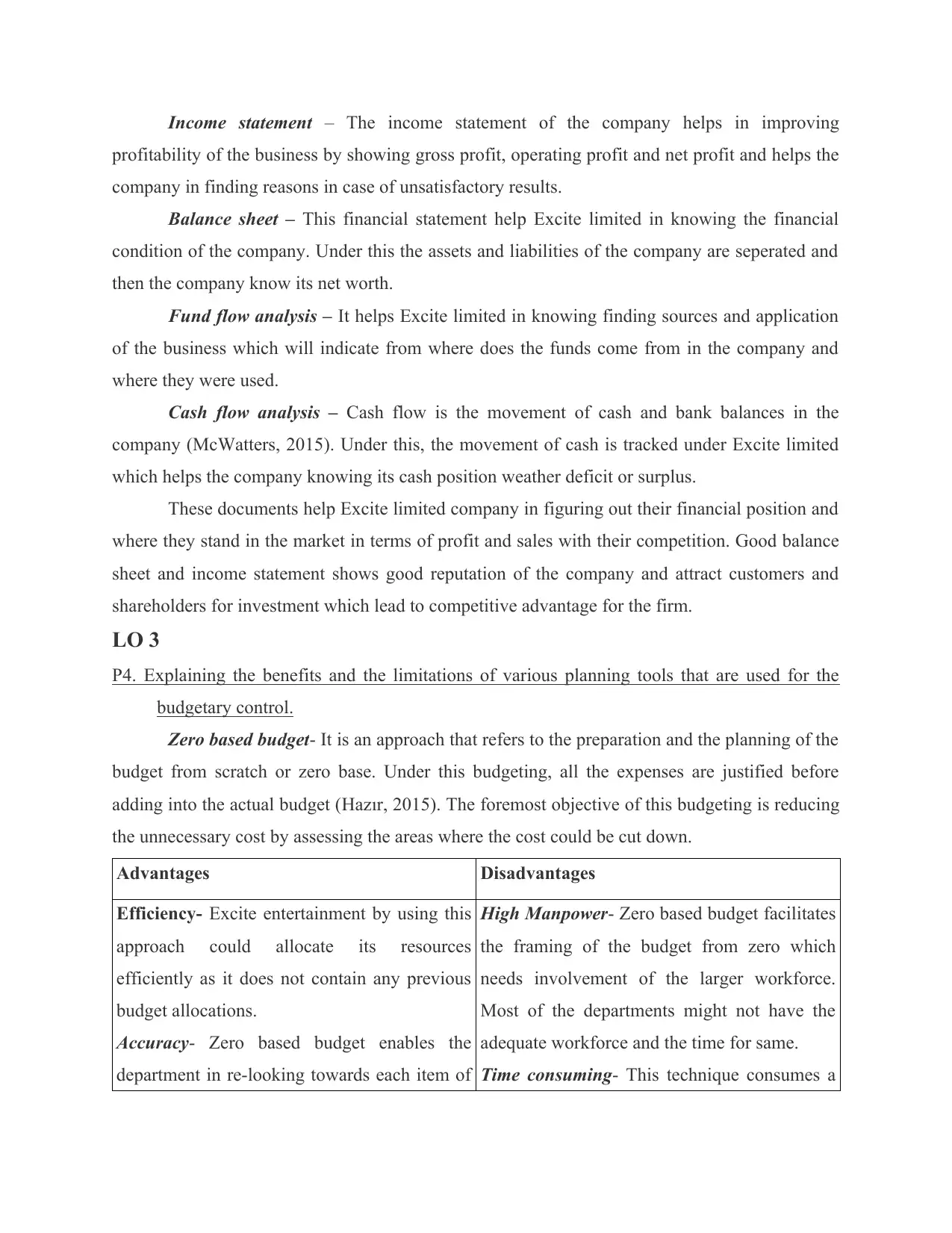
Income statement – The income statement of the company helps in improving
profitability of the business by showing gross profit, operating profit and net profit and helps the
company in finding reasons in case of unsatisfactory results.
Balance sheet – This financial statement help Excite limited in knowing the financial
condition of the company. Under this the assets and liabilities of the company are seperated and
then the company know its net worth.
Fund flow analysis – It helps Excite limited in knowing finding sources and application
of the business which will indicate from where does the funds come from in the company and
where they were used.
Cash flow analysis – Cash flow is the movement of cash and bank balances in the
company (McWatters, 2015). Under this, the movement of cash is tracked under Excite limited
which helps the company knowing its cash position weather deficit or surplus.
These documents help Excite limited company in figuring out their financial position and
where they stand in the market in terms of profit and sales with their competition. Good balance
sheet and income statement shows good reputation of the company and attract customers and
shareholders for investment which lead to competitive advantage for the firm.
LO 3
P4. Explaining the benefits and the limitations of various planning tools that are used for the
budgetary control.
Zero based budget- It is an approach that refers to the preparation and the planning of the
budget from scratch or zero base. Under this budgeting, all the expenses are justified before
adding into the actual budget (Hazır, 2015). The foremost objective of this budgeting is reducing
the unnecessary cost by assessing the areas where the cost could be cut down.
Advantages Disadvantages
Efficiency- Excite entertainment by using this
approach could allocate its resources
efficiently as it does not contain any previous
budget allocations.
Accuracy- Zero based budget enables the
department in re-looking towards each item of
High Manpower- Zero based budget facilitates
the framing of the budget from zero which
needs involvement of the larger workforce.
Most of the departments might not have the
adequate workforce and the time for same.
Time consuming- This technique consumes a
profitability of the business by showing gross profit, operating profit and net profit and helps the
company in finding reasons in case of unsatisfactory results.
Balance sheet – This financial statement help Excite limited in knowing the financial
condition of the company. Under this the assets and liabilities of the company are seperated and
then the company know its net worth.
Fund flow analysis – It helps Excite limited in knowing finding sources and application
of the business which will indicate from where does the funds come from in the company and
where they were used.
Cash flow analysis – Cash flow is the movement of cash and bank balances in the
company (McWatters, 2015). Under this, the movement of cash is tracked under Excite limited
which helps the company knowing its cash position weather deficit or surplus.
These documents help Excite limited company in figuring out their financial position and
where they stand in the market in terms of profit and sales with their competition. Good balance
sheet and income statement shows good reputation of the company and attract customers and
shareholders for investment which lead to competitive advantage for the firm.
LO 3
P4. Explaining the benefits and the limitations of various planning tools that are used for the
budgetary control.
Zero based budget- It is an approach that refers to the preparation and the planning of the
budget from scratch or zero base. Under this budgeting, all the expenses are justified before
adding into the actual budget (Hazır, 2015). The foremost objective of this budgeting is reducing
the unnecessary cost by assessing the areas where the cost could be cut down.
Advantages Disadvantages
Efficiency- Excite entertainment by using this
approach could allocate its resources
efficiently as it does not contain any previous
budget allocations.
Accuracy- Zero based budget enables the
department in re-looking towards each item of
High Manpower- Zero based budget facilitates
the framing of the budget from zero which
needs involvement of the larger workforce.
Most of the departments might not have the
adequate workforce and the time for same.
Time consuming- This technique consumes a
Paraphrase This Document
Need a fresh take? Get an instant paraphrase of this document with our AI Paraphraser
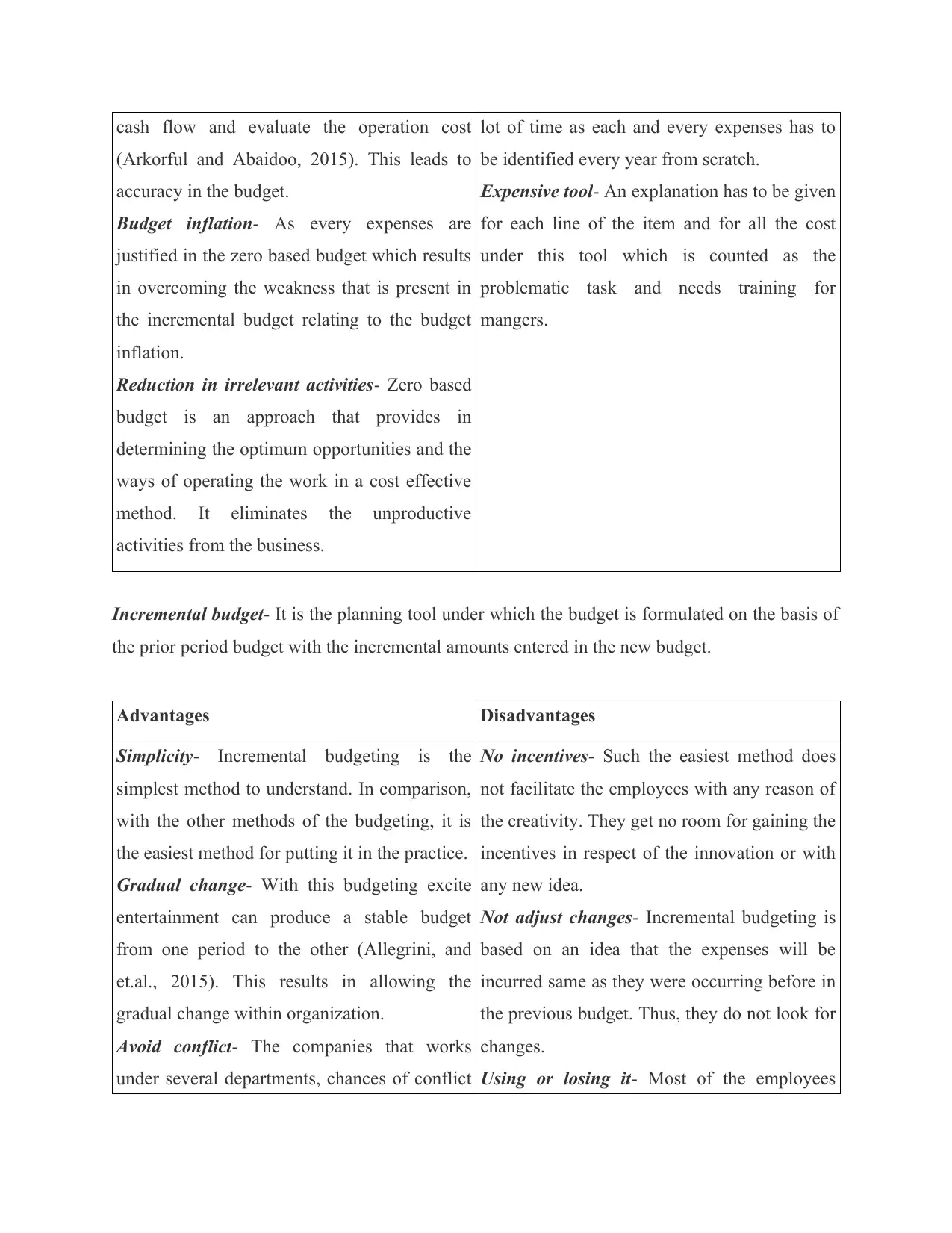
cash flow and evaluate the operation cost
(Arkorful and Abaidoo, 2015). This leads to
accuracy in the budget.
Budget inflation- As every expenses are
justified in the zero based budget which results
in overcoming the weakness that is present in
the incremental budget relating to the budget
inflation.
Reduction in irrelevant activities- Zero based
budget is an approach that provides in
determining the optimum opportunities and the
ways of operating the work in a cost effective
method. It eliminates the unproductive
activities from the business.
lot of time as each and every expenses has to
be identified every year from scratch.
Expensive tool- An explanation has to be given
for each line of the item and for all the cost
under this tool which is counted as the
problematic task and needs training for
mangers.
Incremental budget- It is the planning tool under which the budget is formulated on the basis of
the prior period budget with the incremental amounts entered in the new budget.
Advantages Disadvantages
Simplicity- Incremental budgeting is the
simplest method to understand. In comparison,
with the other methods of the budgeting, it is
the easiest method for putting it in the practice.
Gradual change- With this budgeting excite
entertainment can produce a stable budget
from one period to the other (Allegrini, and
et.al., 2015). This results in allowing the
gradual change within organization.
Avoid conflict- The companies that works
under several departments, chances of conflict
No incentives- Such the easiest method does
not facilitate the employees with any reason of
the creativity. They get no room for gaining the
incentives in respect of the innovation or with
any new idea.
Not adjust changes- Incremental budgeting is
based on an idea that the expenses will be
incurred same as they were occurring before in
the previous budget. Thus, they do not look for
changes.
Using or losing it- Most of the employees
(Arkorful and Abaidoo, 2015). This leads to
accuracy in the budget.
Budget inflation- As every expenses are
justified in the zero based budget which results
in overcoming the weakness that is present in
the incremental budget relating to the budget
inflation.
Reduction in irrelevant activities- Zero based
budget is an approach that provides in
determining the optimum opportunities and the
ways of operating the work in a cost effective
method. It eliminates the unproductive
activities from the business.
lot of time as each and every expenses has to
be identified every year from scratch.
Expensive tool- An explanation has to be given
for each line of the item and for all the cost
under this tool which is counted as the
problematic task and needs training for
mangers.
Incremental budget- It is the planning tool under which the budget is formulated on the basis of
the prior period budget with the incremental amounts entered in the new budget.
Advantages Disadvantages
Simplicity- Incremental budgeting is the
simplest method to understand. In comparison,
with the other methods of the budgeting, it is
the easiest method for putting it in the practice.
Gradual change- With this budgeting excite
entertainment can produce a stable budget
from one period to the other (Allegrini, and
et.al., 2015). This results in allowing the
gradual change within organization.
Avoid conflict- The companies that works
under several departments, chances of conflict
No incentives- Such the easiest method does
not facilitate the employees with any reason of
the creativity. They get no room for gaining the
incentives in respect of the innovation or with
any new idea.
Not adjust changes- Incremental budgeting is
based on an idea that the expenses will be
incurred same as they were occurring before in
the previous budget. Thus, they do not look for
changes.
Using or losing it- Most of the employees
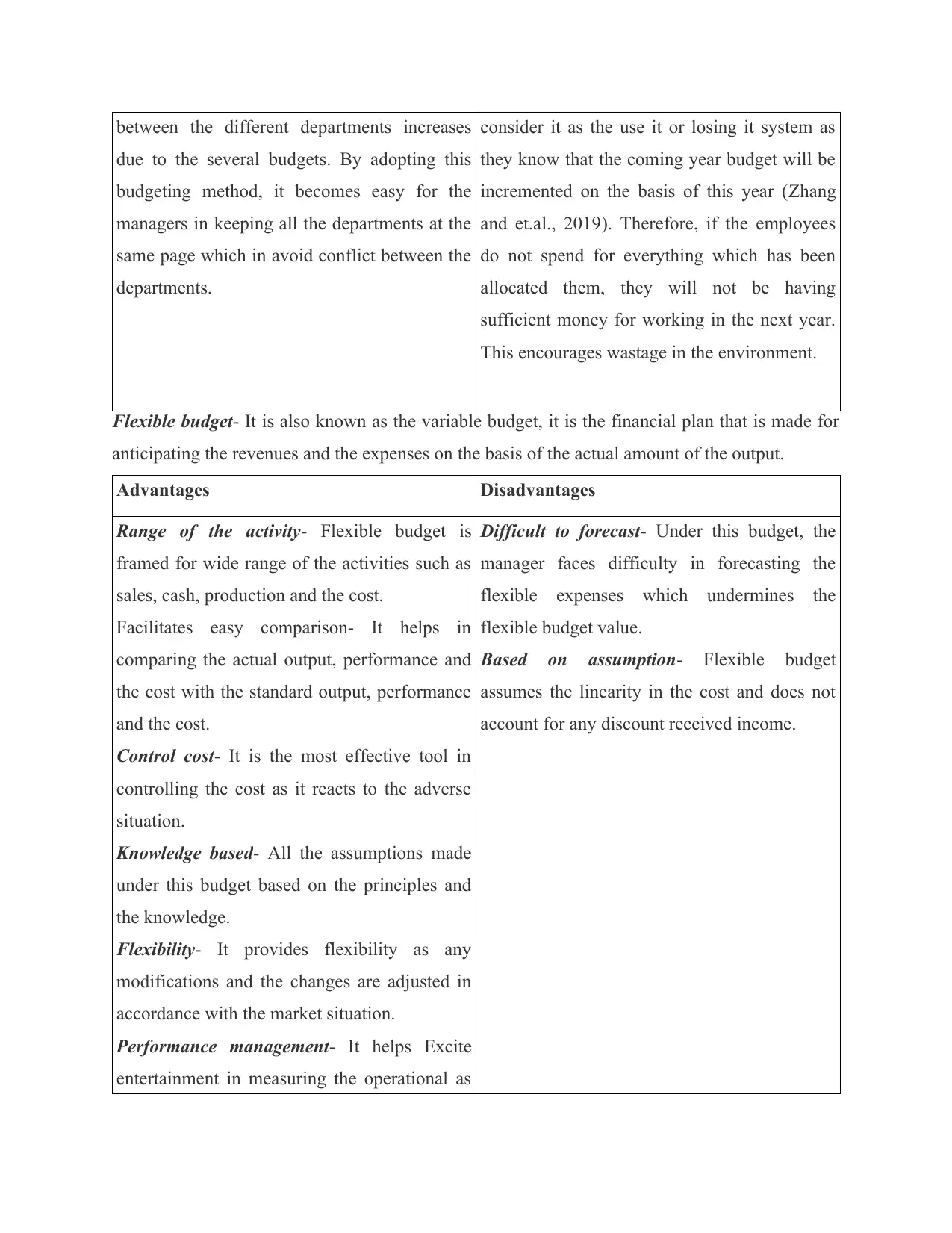
between the different departments increases
due to the several budgets. By adopting this
budgeting method, it becomes easy for the
managers in keeping all the departments at the
same page which in avoid conflict between the
departments.
consider it as the use it or losing it system as
they know that the coming year budget will be
incremented on the basis of this year (Zhang
and et.al., 2019). Therefore, if the employees
do not spend for everything which has been
allocated them, they will not be having
sufficient money for working in the next year.
This encourages wastage in the environment.
Flexible budget- It is also known as the variable budget, it is the financial plan that is made for
anticipating the revenues and the expenses on the basis of the actual amount of the output.
Advantages Disadvantages
Range of the activity- Flexible budget is
framed for wide range of the activities such as
sales, cash, production and the cost.
Facilitates easy comparison- It helps in
comparing the actual output, performance and
the cost with the standard output, performance
and the cost.
Control cost- It is the most effective tool in
controlling the cost as it reacts to the adverse
situation.
Knowledge based- All the assumptions made
under this budget based on the principles and
the knowledge.
Flexibility- It provides flexibility as any
modifications and the changes are adjusted in
accordance with the market situation.
Performance management- It helps Excite
entertainment in measuring the operational as
Difficult to forecast- Under this budget, the
manager faces difficulty in forecasting the
flexible expenses which undermines the
flexible budget value.
Based on assumption- Flexible budget
assumes the linearity in the cost and does not
account for any discount received income.
due to the several budgets. By adopting this
budgeting method, it becomes easy for the
managers in keeping all the departments at the
same page which in avoid conflict between the
departments.
consider it as the use it or losing it system as
they know that the coming year budget will be
incremented on the basis of this year (Zhang
and et.al., 2019). Therefore, if the employees
do not spend for everything which has been
allocated them, they will not be having
sufficient money for working in the next year.
This encourages wastage in the environment.
Flexible budget- It is also known as the variable budget, it is the financial plan that is made for
anticipating the revenues and the expenses on the basis of the actual amount of the output.
Advantages Disadvantages
Range of the activity- Flexible budget is
framed for wide range of the activities such as
sales, cash, production and the cost.
Facilitates easy comparison- It helps in
comparing the actual output, performance and
the cost with the standard output, performance
and the cost.
Control cost- It is the most effective tool in
controlling the cost as it reacts to the adverse
situation.
Knowledge based- All the assumptions made
under this budget based on the principles and
the knowledge.
Flexibility- It provides flexibility as any
modifications and the changes are adjusted in
accordance with the market situation.
Performance management- It helps Excite
entertainment in measuring the operational as
Difficult to forecast- Under this budget, the
manager faces difficulty in forecasting the
flexible expenses which undermines the
flexible budget value.
Based on assumption- Flexible budget
assumes the linearity in the cost and does not
account for any discount received income.
⊘ This is a preview!⊘
Do you want full access?
Subscribe today to unlock all pages.

Trusted by 1+ million students worldwide
1 out of 18
Related Documents
Your All-in-One AI-Powered Toolkit for Academic Success.
+13062052269
info@desklib.com
Available 24*7 on WhatsApp / Email
![[object Object]](/_next/static/media/star-bottom.7253800d.svg)
Unlock your academic potential
Copyright © 2020–2025 A2Z Services. All Rights Reserved. Developed and managed by ZUCOL.





